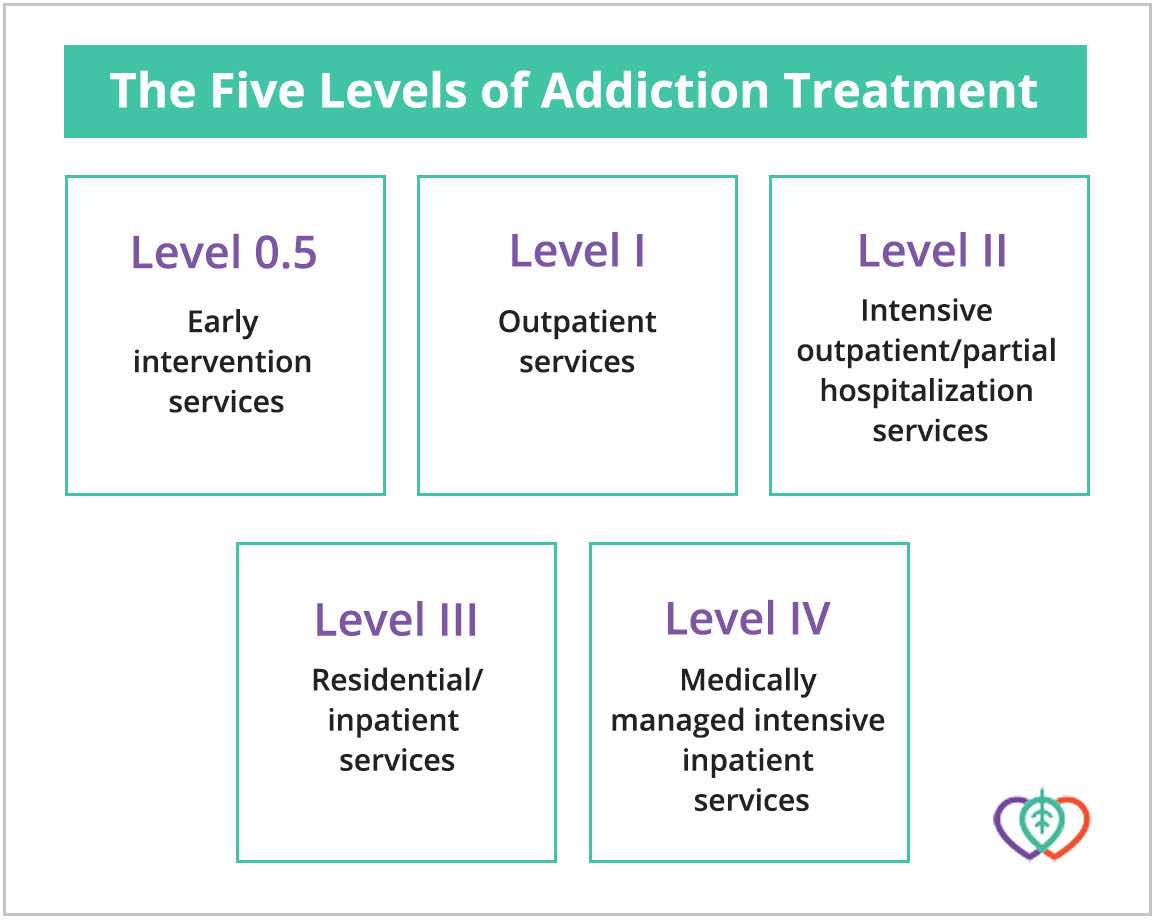What Level Of Care Is Psr Services
| | 5 sources
Every person has different needs when it comes to substance abuse treatment. When patients first enter rehab, it is important they are assigned to the proper level of care.
This approach to handling, or continuum of intendance, ensures that patients receive adequate care upon admission and are smoothly transitioned to a higher or lower level of care as needed. According to the American Society of Addiction Medicine, there are five main levels of treatment in the continuum of care for substance corruption treatment.

The continuum of care was developed to ensure uniformity through the treatment process. This makes what happens in rehab more efficient for patients who transition from ane level of intendance to the next.
Dr. Kevin Wandler of Advanced Recovery Systems discusses the levels of intendance provided by alcohol and drug rehab facilities.
Level 0.5: Early Intervention Services
Early intervention services are a precursor to handling. They are designed for adults or adolescents who are at risk of developing a substance use disorder simply do not display any diagnostic criteria to be admitted to rehab.
During early on intervention, handling focuses on the take chances factors that predispose the person to drug addiction and educates the individual about the negative repercussions of drug misuse.
The elapsing of early intervention services profoundly depends on the patient's understanding of the perils of substance use and whether he or she makes behavioral changes to avert the path to drug addiction. Patients are closely monitored for symptoms that indicate they need a college level of treatment.
Level I: Outpatient Services
Outpatient treatment requires patients to attend regularly scheduled meetings. This level of handling allows patients to carry on with their routine while receiving face-to-face services with addiction or mental wellness professionals. It is ideal for people who take jobs or a strong support system at home, and it typically costs less than other levels of treatment.
Level I care includes evaluation, handling and recovery follow-up services. It addresses the severity of the private's addiction, helps implement behavioral changes and ameliorates mental performance. Patients may transition to the starting time level of handling from a more than robust program. Level I is also a stepping stone for people who are not ready or willing to commit to a complete recovery plan.
Level 2: Intensive Outpatient/Partial Hospitalization Services
The second level of handling tin adjust medical and psychiatric consultation, psychopharmacological consultation, medication management and 24-hr crisis services. The program is affiliated with other levels of treatment in the continuum of care and provides support services such equally kid intendance, vocational training and transportation.
Nanci Stockwell of Advanced Recovery Systems explains why outpatient treatment may be more appropriate for some people in recovery from addiction.
Level Ii.i: Intensive Outpatient Services
This program comprises counseling and teaching about mental wellness and substance use problems. Patients are referred to psychiatric and medical services if addiction specialists deem it necessary. However, intensive outpatient programs cannot treat unstable medical and psychological conditions.
Level II.2: Partial Hospitalization Services
Different intensive outpatient programs, where the patient has to be referred to exterior psychiatric and medical professionals, partial hospitalization provides directly access to those services along with laboratory services.
Level III: Residential/Inpatient Services
Level III of the continuum of care provides residential substance abuse treatment. This level of handling is typically appropriate for patients who accept functional deficits or require a stable living space to help with their recovery.
Nanci Stockwell of Advanced Recovery Systems discusses the advantages of inpatient, or residential, treatment for addiction.
Treatment and assistance are provided around the clock, and the facility is staffed 24 hours a day, seven days a week. The patients may live on site or in a living facility in close proximity to the drug and booze treatment eye then nearby services are readily bachelor.
Level Three.1: Clinically Managed Low-Intensity Residential Services
At this level, services focus on pedagogy recovery skills, preventing relapse and improving emotional functions. Professionals besides help people relearn essential life skills that will benefit them personally and professionally after treatment.
- Outpatient substance corruption services
- A structured recovery environment
- 24-hour staffing
- House meetings
- A community that promotes living skills.
This level of treatment requires the facility to be fully staffed and equipped with handling services.
Level III.3: Clinically Managed Medium-Intensity Residential Services
Also called extended or long-term care, this treatment program provides a structured environs and medium-intensity clinical services. Information technology is designed for patients who have been deeply afflicted by substance abuse, including those showing temporary or permanent cognitive deficits.
Robust treatment is offered at a slower and more repetitive pace to help the patient overcome mental impairments such as Wernicke-Korsakoff syndrome, traumatic brain injury or intellectual inability associated with drug use. This level of treatment provides ongoing instance direction with services including housing, vocational needs, transportation and continued cocky-help meetings. It aims to help patients with societal reintegration.
Level 3.v: Clinically Managed High-Intensity Residential Services
This program is designed for individuals who accept multiple problems and have had a series of unsuccessful interventions. The issues may include substance use disorders, criminal activity, mental disorders, impaired functioning and difficulty adapting to societal norms. Level III.5 caters to people with cluttered, nonsupportive and calumniating relationships.
Level III.vii: Medically Monitored Intensive Inpatient Services
Medically monitored treatment is directed toward individuals with functional deficits such as withdrawal risks, medical issues or emotional issues that forestall the person from progressing in the recovery procedure.
Facilities offer level III.7 handling provide 24-hour professional person evaluations, observation, medical monitoring and addiction treatment.

Level IV: Medically Managed Intensive Inpatient Services
Out of the four levels of treatment, level IV is the most comprehensive and intensive. It offers 24-hr medically directed evaluation, care and handling, including daily meetings with a physician. The facilities are unremarkably equipped with the resources of full general acute care or psychiatric hospitals and offer substance abuse handling that also addresses co-occurring disorders.
The final level of handling focuses on stabilizing patients and preparing them for transfer to a less robust level of treat connected monitoring as they progress toward recovery.
Medical Disclaimer: DrugRehab.com aims to ameliorate the quality of life for people struggling with a substance use or mental health disorder with fact-based content nigh the nature of behavioral health conditions, handling options and their related outcomes. We publish cloth that is researched, cited, edited and reviewed by licensed medical professionals. The information we provide is not intended to be a substitute for professional person medical advice, diagnosis or treatment. It should not exist used in place of the advice of your physician or other qualified healthcare provider.
Author

Author, DrugRehab.com
Sonia Tagliareni is a author and researcher for DrugRehab.com. She is passionate virtually helping people. She started her professional writing career in 2012 and has since written for the finance, engineering, lifestyle and amusement manufacture. Sonia holds a bachelor's degree from the Florida Institute of Technology.
View Sources
- American Club of Addiction Medicine. (n.d.). What is the ASAM Criteria? Retrieved from http://world wide web.asam.org/quality-practice/guidelines-and-consensus-documents/the-asam-criteria/nigh
- Illinois Full general Assembly. (due north.d.). Public Wellness. Retrieved from ftp://www.ilga.gov/JCAR/AdminCode/077/077020600D04010R.html
- National Institute on Drug Abuse. (2012, December). Principles of Drug Addiction treatment: A Research-Based Guide. Retrieved from https://www.drugabuse.gov/publications/principles-drug-habit-treatment-enquiry-based-guide-tertiary-edition/drug-addiction-treatment-in-united-states/types-treatment-programs
- Substance Abuse and Mental Health Services Administration. (2006). Chapter 3. Intensive Outpatient Handling and the Continuum of Care. Retrieved from http://www.ncbi.nlm.nih.gov/books/NBK64088/
- Zander, B. (n.d.). Agreement the bones concept and theory of ASAM. Retrieved from http://www.mh.alabama.gov/Downloads/SATR/ASAM/Module_2_PowerpointSlides.pdf
What Level Of Care Is Psr Services,
Source: https://www.drugrehab.com/treatment/levels-of-care/
Posted by: ellisreenamen.blogspot.com


0 Response to "What Level Of Care Is Psr Services"
Post a Comment